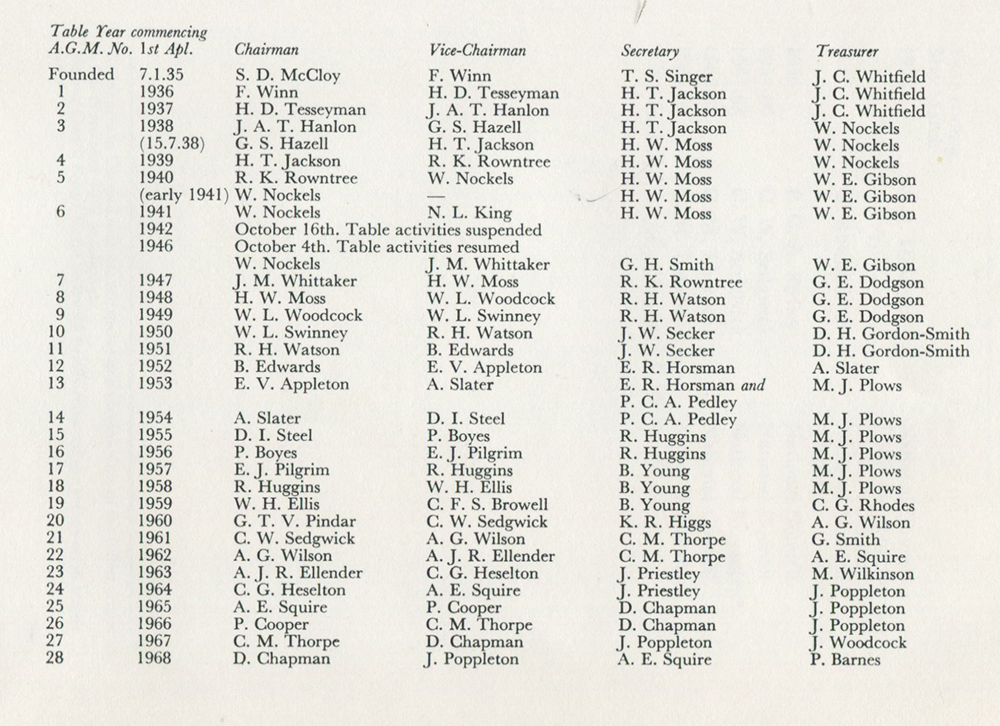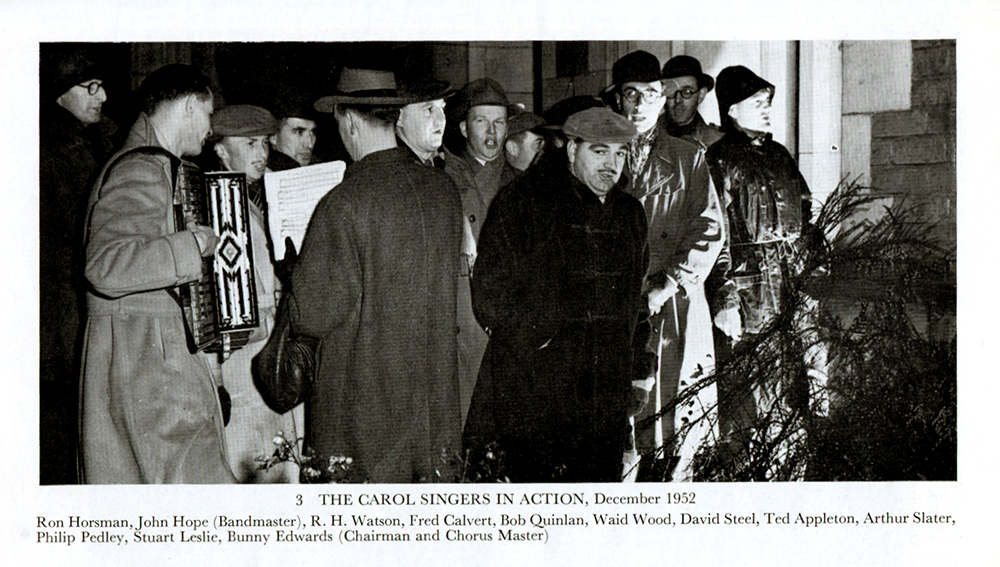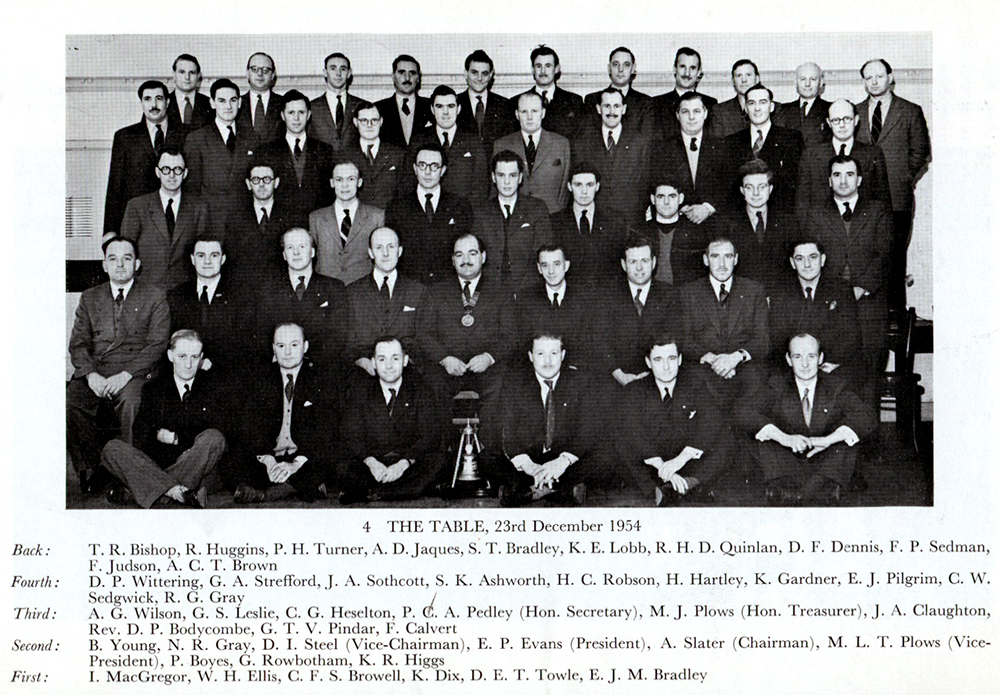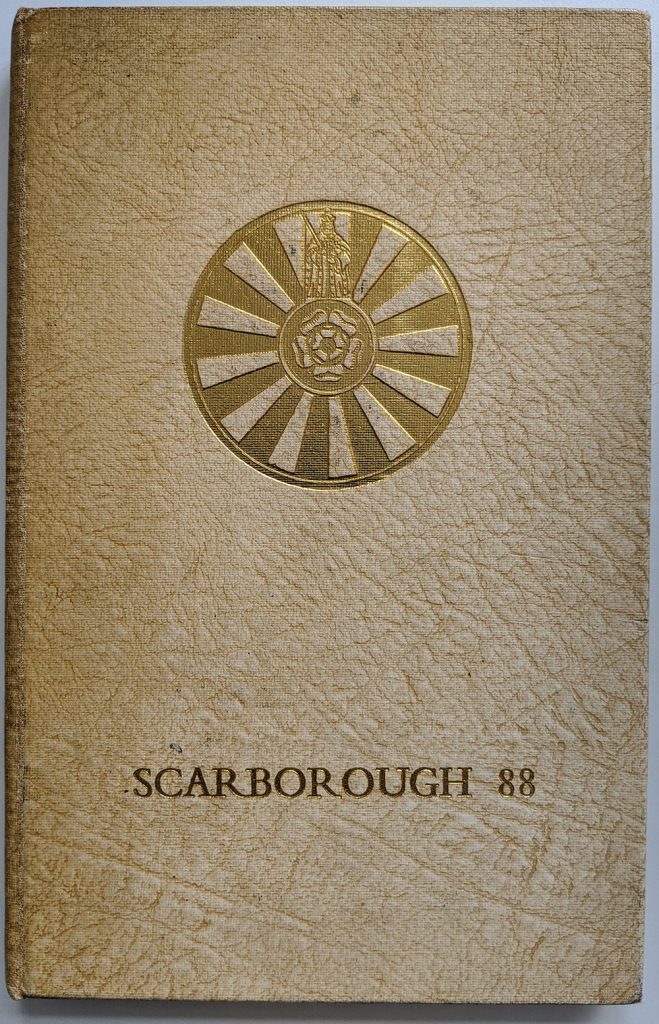Officers of the Scarborough Table

[77]
Scarborough ex-Tablers' Association
Officers of the Scarborough Table

[77]
Note: as discussed at the February 2020 meeting, if you would like to receive email updates directly to your inbox for all articles as soon as they appear on the Scarborough 41 Club website, please subscribe to the site. The subscription box is on the upper right of every page, just below the Search. Techy hint: check your spam inbox if you don’t see the subscription email immediately.
Projects, 1957-61
IT IS, AS IT SHOULD BE, difficult to disentangle Community Service from Fellowship. A glance at Appendix III will remind us, if we need reminding, that no one can say where one begins and the other ends, and vice versa, or even side ways. They merge, and each assumes characteristics of the other.
Such an appendix can be at the best but a guide. It is incomplete in that it deals only with money. There are no statistics for inspiration, compassion, aching muscles in digging gardens, decorating old peoples’ homes, building greenhouses, repairing toys and chopping logs, patience in running garden parties, taking children to pantomimes and picnics, and transporting and entertaining old and handicapped people. No figures of man-hours can be given for the money-raising projects that became progressively more ambitious as the years went on.
Out of the Fellowship of the Table came all these things, which we loosely call Community Service, but out of Community Service came a still stronger fellowship, forging links that have endured.
In this field the 50’s may well be looked upon as preparation for the 60’s. In these years the idea of doing something for others, not merely contributing to a charity box, became firmly fixed in the Table mind.
What was to become an annual event, Carol Singing, started in 1952. Two years later came Higgs’s Bazaar, the first of the annual Jumble Sales. In 17 years the former has raised nearly £900, and the latter over £1,100. Apart from these, the 50’s saw few original ideas beyond dances and fashion-parades. In 1958 the York Table introduced the [40] Scarborough Table to large-scale raffles, for in that year the former enlisted the latter’s help in running a moped competition (How long would the infernal thing tick over on a pint of petrol?).
Scarborough netted £25 of the proceeds and the following year, under the chairmanship of Fred Coopland, the Community Service Committee proceeded to run its own moped competition. Known as Fred’s Folly and organised by Basil Young throughout five weeks of the high season, this raised £91.*
*For those of an enquiring turn of mind, the time was 1hr 24 min. 5.8 sec., and three people tied with 1hr. 24 min 10 sec. How one measures the dying splutters of a petrol engine to a fraction of a second comes under the Official Secrets Act.
The following year it was decided to do the same thing again, but the previous year’s selling site (next to the Lifeboat House on the Foreshore) was no longer available. The aim was to raise some £400 to buy a van for the W.V.S. for their Meals on Wheels service, and it was obvious that a great deal of work was going to be necessary. The project was the largest yet undertaken and was to involve every member of the Table. Tony Squire has vivid recollections of it:
‘We organised a raffle,’ he writes, ‘with the likely first prize of a refrigerator and a week’s holiday in Scarborough for two people. Our sale site was a garage forecourt at the Floral Hall end of North Marine Road and it was manned, through the combined efforts of the Community Service and Entertainment Committees, from 6 p.m. to 8.30 or 9 p.m.
throughout July and August.
‘One of the hazards involved was manhandling the refrigerator, mounted on a dexion display stand, out of the garage on to the forecourt and back again. Though many feet were squashed in the process, it never actually did run down the hill.
‘Steve Lee sticks in my mind as the person who always sold not less than a full book of 5 tickets to any purchaser, his turnover per session being almost double that of any of the other barkers. As a sideline, hotel receptionists were inveigled into selling tickets at 6d commission on cash book sold. In addition to manning the stand, every member of [41] the Table sold £5 worth of tickets, and eventually the first prize was won by a Scarborough couple living in Hatterboard Drive.
‘The project, although using prodigious quantities of man-hours, did achieve success, and a mini-van was duly presented to the W.V.S. at County Garage by Tom Pindar, then Table Chairman.
In all, £369.3.2 was raised. The van and insurance cost £415.15.3. The gap was bridged by an anonymous donation of £40.
The Night of the Dragon
Should this book fall into the hands of any reader not familiar with Scarborough manners and customs, it should be mentioned that for a number of years the town has organised a festival week with continental overtones at the beginning of the season. For many of those years Holland and Scarborough worked together to produce the Dutch Festivals which many visitors still remember with pleasure. One of the highlights was a procession of floats designed to bring the town’s traffic to a standstill on the Wednesday afternoon of the Festival.
In the 1959 and 1960 processions the Table had entered a magnificent 45 foot dragon, thereby winning a silver cup and bringing the whole procession to a halt on the Foreshore.
As these were the years of the moped and the refrigerator, it will be appreciated that the Table had not a great deal of spare time on its hands.
After the 1960 procession it was not unreasonably felt that for display purposes the dragon had had its day, and the problem was what to do with the beast. It took up a lot of room. No other Table wanted to buy it, but it was far too attractive to consign to the knacker’s yard.
Loch Ness was at this time receiving some of its periodical publicity. Arch-schemer Arthur Holmes saw no reason why a North Sea monster should not appear in the bay on August Bank Holiday. What followed is best described by Eric Rushforth:
‘A committee was co-opted and flotation trials were carried out in Scalby Beck with one middle section 16 feet long by 4 feet in diameter, and a plan of action was put into [42] operation at 0200 hours on Bank Holiday Sunday at Burniston Road car park.
‘Transport was ably provided as usual by the vans of Tony Squire and Jack Knowles, and the loading of the eight large sections completed in darkness and transported to the Golden Ball slipway, where the construction party of Peter Dean, Eric Rushforth, John Priestley, Derek Towle, etc. started to secure three car inner tubes into, and a two-gallon can full of sand as ballast under, each section.
The 7 foot dragon’s head had a 10 foot pole centred up the neck, and each body section was then secured by rope along the whole body. The effect was fantastic as the 45 foot dragon, riding high in the sea, was towed as dawn was breaking by motor launch (thanks to Arthur Slater) to a point in the middle of the South Bay and anchored at 0600 hours.
‘The gentle waves caused the whole green and gold creature to undulate, and from the shore it appeared to be alive, much to the amazement of the visitors who, half an hour later, were beginning to appear in numbers along the Foreshore.
‘As the Harbour Master was reporting an unidentified floating object to the police, the tired, wet and dirty working party were consuming bacon and eggs in an early-morning cafe. Ken Dix had a very profitable day as his reports and photographs appeared next day in every national newspaper – a total of 67 single column inches – and Ken was paid for every word.
‘The sequel at 8 p.m. on that glorious Sunday was when a party of brave dragon-killers ably led by Stuart Leslie, armed with rifles, set sail and towed the dragon three miles out to sea. There she was suitably despatched to Davy Jones’s Locker, a memorable ending to an entertaining dragon.’
The First Wykeham Garden Party
The last project to be undertaken prior to the 1962 Conference was a Garden Party and Barbecue held at Wykeham Abbey, the seat of Lord and Lady Downe.
We are indebted to Tom Pindar for his graphic recollections of this party, held in 1961, which turned out to be the [43] largest project so far undertaken:
Quite where the idea came from I have forgotten, but it was a good one. Two of us were deputed to visit web to approach Lord Downe and discuss arrangements. We were received in the Brown Drawing Room and had an an amusing time listening to the Peter Sellers record of ‘Balham – Gateway to the South’ and ‘The Family Retainer’ at which his Lordship rocked in his chair with laughter, with John Ellender a good second.
This beginning made us feel much more at home, and since then many people have come to have a greater affection and respect for Wykeham Abbey and those to whom it is home.
It was eventually decided to have a Garden Party in the afternoon with a monster Chicken Barbecue in the evening. The whole Table was involved in preparation and gradually we realised just how much work was necessary. Dennis Hart’s reputation as an intrepid driver of coal lorries grew apace as he ferried chairs and tables, side-shows, cooking gear and much more. I recall Peter Dean demonstrating a fine nautical vocabulary after narrowly escaping death at Dennis’s wheels.
Bit by bit the place was prepared and Lady Downe’s memories of a pre-war Red Cross Garden Party and the siting of stands were invaluable. Barbecues were already growing in popularity, but we had little experience of cooking for them and could only guess at probable numbers. So a decision was taken: 500 chickens would be cooked, providing, I think, half a bird to each person. Brian Gooch, who was the assistant manager of the gas works, produced yards of pipe, concocted a large area of gas burners over which dixies of soup and the chickens were to be heated.
A marquee was erected for dancing, and other members erected a hitherto unparallelled network of notices and posters. Wives arranged teas in the coachyard, and miles of wire went up for lighting and public address systems. Gradually one realised what an ideal place we had for the job: there were even strategically placed toilets.
Memory of the actual day remains something of a blur. We were involved in doing our jobs, and as the evening wore on it seemed there would never be an end to serving [44] chickens. Too soon, however, they were finished, and suspicions were confirmed that certain citizens had come back for second helpings.
There was a lot of clearing up to do, and then came the inquest. The lesson learned was simple. In order to make full use of the day we had staged what amounted to two events, of which the Barbecue needed most work, caused most worry and made only a minimal surplus. But it was a first-class bit of experience, and we raised a goodly sum for the Y.M.C.A.
The net sum raised was £448.3.8, and £450 went to the Y.M.C.A. This was not the only benefit, for the experience was to prove invaluable in 1964 and again in 1967, the years of the second and third Wykeham Abbey Garden Parties. [45]
Note: as discussed at the February 2020 meeting, if you would like to receive email updates directly to your inbox for all articles as soon as they appear on the Scarborough 41 Club website, please subscribe to the site. The subscription box is on the upper right of every page, just below the Search. Techy hint: check your spam inbox if you don’t see the subscription email immediately.
The Difficult Years, 1946 – 52
THE TABLE MEETING called pursuant to the minute of 16th October 1942 was held on Friday, 4th October 1946, when lunch was taken by 16 members at the St. Nicholas Hotel,
Twelve years earlier the Table had successfully accomplished its first major task, its own formation, a task in which it had had no previous experience. The present task, in which again it had had no previous experience, was to revive itself from its long and enforced coma.
The same old members got together, all from four to seven years older and perhaps wiser. Some, too, in those lost years had passed the 40-mark. They were the same, yet not the same. Others, for one reason or another, did not reappear at all.
It was obvious that after a gap in recruitment of seven years the average age of the Table had taken a leap upwards. For some time to come there would inevitably be an old brigade of experienced members and an inexperienced younger intake of new members.
These matters were discussed by the Council. As a temporary measure Walter Nockels had resumed his interrupted Chairmanship, and the other officers (with the exception of President and Vice-President) were elected to serve until the first post-war Annual General Meeting, the Table’s seventh, which was eventually held on 15th April 1947.
The Council itself resolved to take over the duties of the Membership Committee, which it continued to perform for the next five years. Its first act was to write to all old members asking whether they wished to continue their membership. In the meantime the National Council had been busy and eventually was able to give the Tables a much-needed ruling [21] on the status of the over-40’s:
Any person who was an active member on 30.9.39 and is still in membership is entitled to remain a member until 31.3.48. In all other cases a member must retire at the end of the year in which he attains the age of 40. The Classification of a member over 40 is considered vacant.
The first few post-war meetings had an average attendance of 16, which soon began to climb. At a special evening meeting held five months later, at which Round Table in general and the Scarborough Table in particular were dealt with in some detail, the attendance had risen to 26.
The annual subscription was raised from 15/- to £1.1. The day of the fortnightly lunch was altered to alternate Tuesdays at the Salisbury Hotel at a cost of 5/- plus 6d. gratuity. At this time the Charity Box contained £4.2.4, which was made up to £5 and given to the Mayor’s Flood Relief Fund. The Christmas Lunch and the Annual Dinner and Dance were revived in 1947.
The latter was held on the 27th November at the Pavilion Hotel and the Table, in those days of rationing and shortages, let itself go. The following was the Dinner menu:
Hors d’oeuvre des Epicuriens
Consommé à la Souveraine
Faisan à la Broche
Coeurs de Celeris à la Moelle
Pommes Croquettes et Nature
Salade Verte a l’huile
Ananas Parisienne
Biscuit Glace Formosa
Langues de Chats
Cafe Moka
The dancing then started at 9.15 p.m. An hour and three quarters later Supper was served, with the following menu:
Sandwich Fingers, Chicken, Smoked Salmon, Ox Tongue.
Bridge Rolls, Cheese and Celery, Paté de Foie Gras.
Patties, Turkey, Oyster, Lobster.
Miniature Aspics, Prawn, Anchovy, Lucille.
Gateaux, Suchard, Moka, Parisienne.
Pastries, Eclairs, Linzer, Mille Feuilles, Religieuse.
Sweets, Fruit Cocktail Jellies, Bavarois Rubanne.
Ices, Vanilla, Creme de Menthe.
Petits Fours, Friandises, Fours Sec.
There is a moral here, somewhere, not perhaps obvious to the younger members of the Table. There was a young guest [22] who, some years later, was to become a member of the Table. His comments, which are to be found on a later page, are probably not far from the mark, for he had grown up through the lean years.
‘The cost?’ says Roundabout 200. We’re not sure, but memory thinks it was about a guinea cache, and it was all in the days of rationing.
It takes much art
To choose à la carte
For less than they quote
For table d’hôte.
War Weariness
In the immediate post-war years the Table was successful in regaining its strength, but something was lacking. War-weariness was the current term for a national attitude of mind. It manifested itself in many ways. Many a young man, after eventful service in the armed forces, found it difficult to accommodate himself to the less eventful routines of his old job. Many an older man, faced with the task of commercial and industrial reconstruction in the shadow of severe controls, found he had little time and energy left for commitments outside his own job. Broadly speaking the whole country was, above all, tired of the disciplines of war and did not much care for further regimentation in any shape or form, even the mild regimentation of the Table.
The result can be seen in the Table’s immediate post-war history. For five years its activities were predominantly social. In and after 1948 it assisted the W.V.S. and later undertook the distribution of the food parcels the Association of Kinsmen Clubs was sending from Canada. In 1950 it sent a donation of £10.10 to R.T.B.I’s Manitoba Flood Relief Fund. In this connection it is worthy of note that the total Round Table gift to the stricken province amounted to £8,513.9.6 and was second in size only to that of the British Government itself. The money was spent on pedigree cattle and medical equipment, which were shipped to Canada for distribution by the Kinsmen’s Association.
But these activities were few and sporadic. It was not until 1951 that the Table began to regain its old spirit of Community Service,
The Area, however, was more energetic. Extension was in [23] the air, and the Area Council was soon discussing the formation of Tables at Selby, Harrogate and Malton, and the re-forming of the Bridlington Table. Scarborough was asked to report on the possibilities in Malton and decided that the formation of a Table there at that time to be impracticable.
An Area dinner was held at Scarborough on 4th November 1948 at which the National President attended, and Bridlington’s Charter Night was held on 17th March 1950.
Community Service
In 1951 the membership of the Table was 35. E. V. Appleton was Chairman of the Community Service Committee, and under his guidance an interest in the needs and problems of disabled ex-service men began to grow. The Table’s first modest post-war Community Service effort was to entertain them to an evening film-show in October.
The following March the Table ran a coach trip to Hull to a football match for the benefit of members of the British Limbless Ex-Servicemen’s Association, and later in the year entertained them at the Silver Grid. Apart from the personal assistance of Table members, these ventures were costly for a small Table, and the question of finance arose. In this year we find that the Charity Box was discontinued and each member was to pay 10/- per annum in lieu of the contributions they otherwise would have put in it.
In this year, too, under the Community Service chairmanship of G. S. Leslie, assistance was given to a charitable garden party, 2,000 Christmas seals were sold in aid of the T.B. Aftercare Association and Christmas parcels were delivered to 13 needy families.
In one other respect, however, 1952 was a historic year. In order to raise funds for community service it was decided to form a carol-singing party. This was the start of one of the Table’s most popular annual activities. Various comments have been made from time to time on the quality of the singing, especially towards the end of an evening’s round among the more hospitable ports of call. Nevertheless, as the years passed, the singers were to become one of the largest annual money-raising groups in the Table.
The Income and Expenditure Account for the year ended 31st March 1953 gives some idea of the re-birth of Community [24] Service in the Table and of the momentum that was to carry it into the major undertakings of later years. The funds raised reached the then astonishing figure of £64.6.9, of which £29.15 came from the Charity Levy and £34.11.9 from such efforts as a film show, motor trials and, of course, the carol singing. The modest disbursements are shown as:


Ex-servicemen’s outing to Hull – £8.10.0
Lynmouth Fund – £5.5.0
Ex-servicemen’s outing – £8.2.11
Mayoress’s Christmas Fund – £12.10.0
The year finished with a balance of charity funds in hand of £39.16.7. This, and more, was soon going to be needed for what was to be the Table’s biggest single charitable gift so far, and the forerunner of bigger ones still.
It is worthy of mention that this was the first year of Michael Plows’s duties as Treasurer, which he was to fulfil for the record period of six years. He held the added distinct son of being the first so of an old member of the Table to be elected to membership. [25]
Note: as discussed at the February 2020 meeting, if you would like to receive email updates directly to your inbox for all articles as soon as they appear on the Scarborough 41 Club website, please subscribe to the site. The subscription box is on the upper right of every page, just below the Search. Techy hint: check your spam inbox if you don’t see the subscription email immediately.

Note: as discussed at the February 2020 meeting, if you would like to receive email updates directly to your inbox for all articles as soon as they appear on the Scarborough 41 Club website, please subscribe to the site. The subscription box is on the upper right of every page, just below the Search. Techy hint: check your spam inbox if you don’t see the subscription email immediately.
Charlie's chosen charity for 2023-24 is the Stroke Association.
All Scarborough 41 Club meetings normally start at 7.30pm for 8.00pm unless otherwise advised. Events subsequent to those listed below appear via the Calendar link in the top menu.
Meetings are held usually on the second Thursday of each month, September to May each year. Please see the Calendar for times and venues. If you are an ex-Tabler visiting Scarborough, or you would like to join the Club, please contact the Club Secretary.
Members' apologies should be received no later than noon on the Friday* before the regular Thursday meeting, unless advised separately otherwise. Please use the website Apology Form.
*change made at the 2015 AGM
To get in touch with the Club on any general matter, please contact the Club Secretary.
To submit articles, photos and other material for the website, please contact the Web Editor.
For website technical support/queries: please contact the Web Developer.
Copyright © 2024 · Scarborough 41 Club · scarborough41club.co.uk ·website CMS by hendersonline.com · Log in